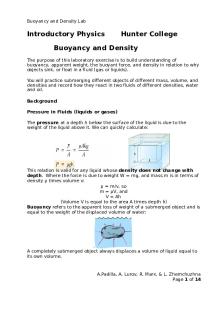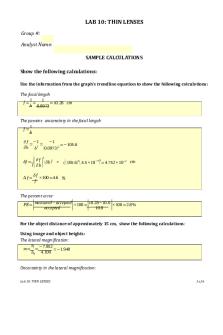Lab # 10 PDF

| Title | Lab # 10 |
|---|---|
| Author | Muhammad Ehsan Ullah |
| Course | Electronic Devices |
| Institution | Riphah International University |
| Pages | 4 |
| File Size | 324.2 KB |
| File Type | |
| Total Downloads | 47 |
| Total Views | 157 |
Summary
Best lab report...
Description
03/12/2019
Lab Title: To obtain common emitter characteristics of NPN transistor.
Objective:
To study input and output characteristics of a NPN Bipolar Junction Transistor (BJT) in Common-emitter configuration.
Introduction Of Theory:The transistor is a two junction, three terminal semiconductor device which has three regions namely the emitter region, the base region, and the collector region. There are two types of transistors. An npn transistor has an n type emitter, a p type base and an n type collector while a pnp transistor has a p type emitter, an n type base and a p type collector. The emitter is heavily doped, base region is thin and lightly doped and collector is moderately doped and is the largest. The current conduction in transistors takes place due to both charge carriers- that is electrons and holes and hence they are named Bipolar Junction Transistors (BJT).
Common Emitter Amplifier: The common emitter amplifier is a three basic single stage bipolar junction transistor and is used as a voltage amplifier. The input of this amplifier is taken from the base terminal, the output is collected from the collector terminal and the emitter terminal is common for both the terminals. The basic symbol of the common emitter amplifier is shown below. 1|Pa ge
26961
The bias vs gain common emitter amplifier transistor characteristics, if the R2 resistor increases then there is an increase in the forward bias and R1 & bias are inversely proportional to each other. The alternating current is applied to the base of the transistor of the common emitter amplifier circuit then there is a flow of small base current. Hence there is a large amount of current flow through the collector with the help of the RC resistance. The voltage near the resistance RC will change because the value is very high and the values are from the 4 to 10kohm. Hence there is a huge amount of current present in the collector circuit which amplified from the weak signal, therefore common emitter transistor work as an amplifier circuit.
Circuit Diagrams:
For Input characteristics:
For output characteristics:
2|Pa ge
26961
Practical Work: Equipment:
DMM Breadboard Resistors LED Transistor 2N3904 ------------
NPN
Procedure: For Input characteristics:
Connect circuit as shown in the circuit diagram for input characteristics Connect variable power supply 0-30V at base circuit and collector circuit. Keep Vcc fix at 0V (Or do not connect Vcc) Increase VBB from 0V to 20V, note down readings of base current Ib and base to emitter voltage Vbe in the observation table. Repeat above procedure for Vcc = +5V and Vcc = +10V Draw input characteristics curve. Plot Vbe on X axis and Ib on Y axis.
For output characteristics:
Connect circuit as shown in the circuit diagram for output characteristics Connect variable power supply 0-30V at base circuit and collector circuit. Keep base current fix (Initially 0) Increase VCC from 0V to 30V, note down readings of collector current Ic and collector to emitter voltage Vce in the observation table. Repeat above procedure for base currents Ib = 5μA, 50 μA, 100 μA. Increase base current by increasing VBB. Draw output characteristics curve. Plot Vce on X axis and Ic on Y axis.
Tabular & Graphical Data :Input Table: S. No. 1 2 3 4 5 6 7 8 9 10
VCC = 0V VBE 0.52 0.54 0.54 0.54 0.55 0.55 0.56 0.56 0.57 0.57
IB 10 30 50 70 90 110 140 160 180 200
VCC = 5V
VCC =10V
VBE 0.5 0.5 0.5 0.52 0.54 0.54 0.56 0.57 0.57 0.57
VBE 0.5 0.56 0.56 0.56 0.56 0.57 0.57 0.57 0.57 0.57
IB 10 30 50 70 90 110 140 160 180 200
IB 10 30 50 70 90 110 140 160 180 200
Output Table: S. No. 3|Pa ge
IB = 0 µA
IB = 5 µA
IB =50 µA 26961
VCE
IC
VCE
IC
VCE
IC
1
0.008
0
0.02
5
0.5
1.8
2
0.003
0
1.8
780
0.8
5.2
3
5.4
0
4.6
792
0.9
8.4
4
8.5
0
8.4
796
3.4
10
5
11.6
0
11.2
804
5
11.1
6
16.2
0
14.02
806
5.9
11.5
7
19.8
0
16.08
812
10.9
11.8
8
22.1
0
18
816
13
11.85
9
22.6
0
19.6
818
14
12.25
10
22.8
0
20.3
912
15
13.45
Discussion of Results :In this lab we have to learnt about the behavior of transistor and also study about the common emitter amplifier and also find the voltages and current with help of DMM having different values. After that find the output and input voltages by the given circuit and make the waveform with the help of different values. .
Conclusion: This lab is about to common emitter characteristics of NPN transistor. After that observe the working of common emitter amplifier. And find the input and output voltages and currents. After that make the waveform of different values.
References:
https://www.electronics-tutorials.ws/blog/relay-switch-circuit.html
https://www.slideshare.net/khaileselassie/lab-8-bipolar-junction-transistor-characterstics
4|Pa ge
26961...
Similar Free PDFs

Lab 10 - Lab 10
- 17 Pages

Lab 10 - Lab 10 Report
- 7 Pages

GEOG Lab 10 - lab 10
- 4 Pages

Lab 10 - PH111 LAB
- 2 Pages

Lab 10
- 14 Pages

Lab # 10
- 4 Pages

Lab 10
- 4 Pages

Lab 10
- 5 Pages

Orgo 2 Lab 10 - Lab Report 10
- 4 Pages

Post lab 10 - Post lab 10
- 3 Pages

Lab 10 - Lecture notes 10
- 3 Pages

Chem lab 10 - lab report
- 9 Pages

Phys lab 10 - Lab report
- 14 Pages

Practica lab 10
- 15 Pages

Lab 10 thin lenses
- 6 Pages

eScience Lab 10: Cells
- 6 Pages
Popular Institutions
- Tinajero National High School - Annex
- Politeknik Caltex Riau
- Yokohama City University
- SGT University
- University of Al-Qadisiyah
- Divine Word College of Vigan
- Techniek College Rotterdam
- Universidade de Santiago
- Universiti Teknologi MARA Cawangan Johor Kampus Pasir Gudang
- Poltekkes Kemenkes Yogyakarta
- Baguio City National High School
- Colegio san marcos
- preparatoria uno
- Centro de Bachillerato Tecnológico Industrial y de Servicios No. 107
- Dalian Maritime University
- Quang Trung Secondary School
- Colegio Tecnológico en Informática
- Corporación Regional de Educación Superior
- Grupo CEDVA
- Dar Al Uloom University
- Centro de Estudios Preuniversitarios de la Universidad Nacional de Ingeniería
- 上智大学
- Aakash International School, Nuna Majara
- San Felipe Neri Catholic School
- Kang Chiao International School - New Taipei City
- Misamis Occidental National High School
- Institución Educativa Escuela Normal Juan Ladrilleros
- Kolehiyo ng Pantukan
- Batanes State College
- Instituto Continental
- Sekolah Menengah Kejuruan Kesehatan Kaltara (Tarakan)
- Colegio de La Inmaculada Concepcion - Cebu